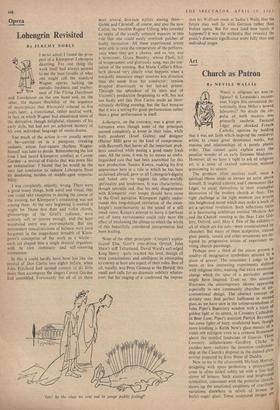Art
Church as Patron
By NEVILE WALLIS
WHEN is religious art non-re- ligious? Is Leonardo's .myster- ious Virgin less committed de-
votionally than Millets bowed labourers? No doubt the im- pulse of both masters was primarily aesthetic. Fernand Ldger once shocked French Catholic opinion by holding that it was not faith which inspired the mediwval artists to create great devotional works, but reasons and relationships of a purely plastic order. That cannot quite explain away the peculiar wonder of an early Siennese Madonna. However, all we have a right to ask of religious art is a sense of exalted conviction without questioning its source.
The problem often resolves itself, since a spiritual theme tends to elevate an artist above himself. It inspired atheists, and Communists like Leger, to excel themselves in their triumphal decoration of the modern church at Assy. The right challenge at the right moment can arouse this heightened mood which may make a work of art a spiritual revelation. Such reflections recur at a fascinating exhibition entitled 'Modern Art , and the Church' running at the Bear Lane Gal- lery, Oxford, until May 4. Few of the exhibits— all of which are for sale—were commissioned by churches. But many of these sculptures, stained glass panels, vessels and other ornaments are de- signed by progressive artists of experience in- viting church patronage. Perhaps over a third of the pieces possess a quality of imaginative symbolism attuned to a place of prayer. The remainder I judge to be more or less interesting experiments dubbed with religious titles, wanting that extra emotional charge which the spur of a particular setting might have inspired. Even. so, this selection illustrates the contemporary idioms appearing especially in new community churches of un- conventional design. The abstract concept of divinity may find perfect fulfilment in stained glass as we have seen in the colour-symbolism of John Piper's Baptistery window with a blaze of golden light at its centre, in Coventry Cathedral. In Bear Lane, Piper's assistant Patrick Reyntlens has some lights of hazy, modulated hues, though more kindling is Keith New's glass mosaic of a violet orb refulgent even in a crimson firmament above the mottled landscape of Genesis. These Coventry collaborators—Geoffrey Clarke is another here—'indicate the inventive craftsman- ship at the Church's disposal in the stained glass revival prepared by Evie Hone of Dublin. New to me is the silversmith Michael Murray, designing with spare perfection a processional cross in silver nickel subtly set with a four-leaf clover of bronze. Such austere and heightened symbolism, consonant with the primitive church, shows up the emotional emptiness of cruciform variations elsewhere in reliefs of bronze or barley-sugar glass'. Tense sculptural images are
indeed provided by Willi Soukop and Dobson's assistant Arthur Pollen, but there is no doubting the dearth in this field. The most impassioned modern reredos I know is rather a drama of everyday life : Gisha Koenig's terra-cotta relief of a crucifixion in the working-class London church of St. John's, Earlsfield. Here the curious crowds and fascist soldiery closing in on the martyr, and carpenters hammering about on scaffolding, reveal the intense Jewish humanism which can make of social realism a spiritual ex- perience.



































 Previous page
Previous page